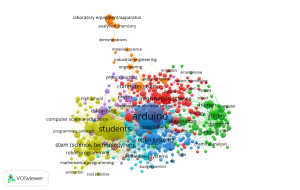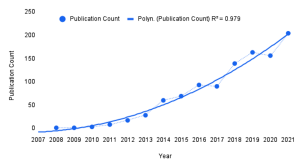The Implementation of Arduino Microcontroller Boards in Science A Bibliometric Analysis from 2008 to 2022
Research Title[edit | edit source]
The Implementation of Arduino Microcontroller Boards in Science: A Bibliometric Analysis from 2008 to 2022
Research Question[edit | edit source]
How has the use of Arduino microcontroller boards (MCBs) in science research evolved over time?
Methodology[edit | edit source]
The researchers conducted a bibliometric analysis on 1122 papers focused on microcontroller research published in the Scopus database from 2008 to 2022. PRISMA, also known as, The Preferred Reporting Items for Systematic Reviews and Meta-Analyses, was used as a reference for the research protocol to screen the database.They analyzed various aspects of the selected papers, such as authors, titles, publication years, keywords, citations, affiliations, abstracts, funding information, and languages. The data was visualized and analyzed to identify trends and patterns. An open-source software, VOS viewer Version 1.16.18, was used to visualize the bibliometric networks in this study.

Results[edit | edit source]
The analysis revealed a significant increase in the number of articles on Arduino boards in fields like biology, physics, chemistry, science, and STEM. Despite using only the Scopus database, the study highlighted the growing application of Arduino boards in science. Arduino boards continue to challenge researchers and educators for creativity and innovation to solve common science problems, such as in sensor automation, networking and data acquisition. From the total articles used in the bibliometric analysis, 67.1% strongly relates with STEM and Education. The rest of the articles focusing on Physics, Biology, and Chemistry respectively are 12.1%, 6.3%, and 7.9%. It has been supporting the rise of the new term ChemDuino (a portmanteau of Chemistry and Arduino) since 2015.

Furthermore, the regression modeling revealed a good fit for the yearly records from 2008 to 2021. A polynomial regression curve with an R2 value of 0.979 was identified, following the equation y = 0.953x2 - 3825x + 3840000 smoothly. This equation indicates a trend towards an exponential increase in the number of publications, strongly affirming the growing enthusiasm for research on the topic. The implementation of Arduino boards offers educators a means to promote IoT, Artificial Intelligence, 3D modeling, and hands-on activities for remote students, including take-home lab exercises. Over the past decade, various website communities, such as https://www.instructables.com/ and https://www.tinkercad.com/ have been widely used and cited in top publications. The use of Arduino projects in learning interventions has been reported to significantly enhance students' STEM academic achievements and perceptions towards STEM, spanning from primary education to higher education.The details regarding the skillset acquired by users, challenges faced when using the boards, and learning outcomes are elaborated in the results and discussion section of the manuscripts.
Implications[edit | edit source]
The study's findings suggest that Arduino boards are increasingly being used in various scientific research fields. This could lead to new innovations and advancements in science education and industry. The bibliometric analysis serves as a comprehensive guide for future collaborations in education and industry, helping researchers and practitioners better understand the trends and applications of Arduino boards in science. Surprisingly, the percentage of articles connected to the embedded health measurement systems using Arduino boards is about 6.6% from the total of articles screened. We predict that the percentage of publications in healthcare services will continue to grow in the future.
Acknowledgements[edit | edit source]
We would like to express our gratitude to Dr. Maria Paristiowati, M.Si. and Prof. Dr. Erdawati.M.Sc., from the State University of Jakarta, as well as Lie Miah, S.T.P., Dwi Endah Prasetya Rini, S.Farm., and Anthea Calista, S.T., M.M., from the Chemistry Department of SPK SMAK PENABUR Kelapa Gading, for their valuable feedback and comments on our overall research manuscripts.